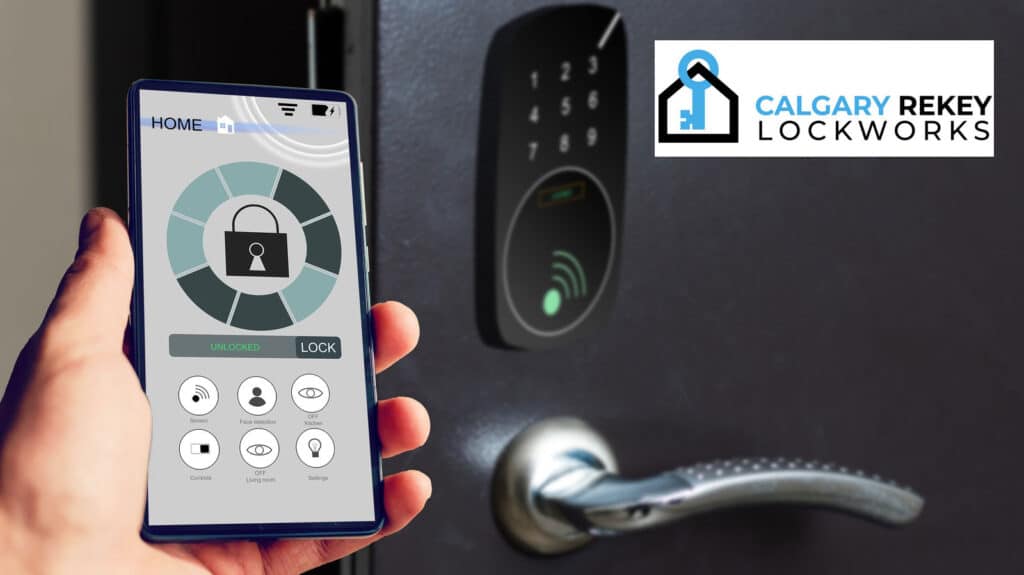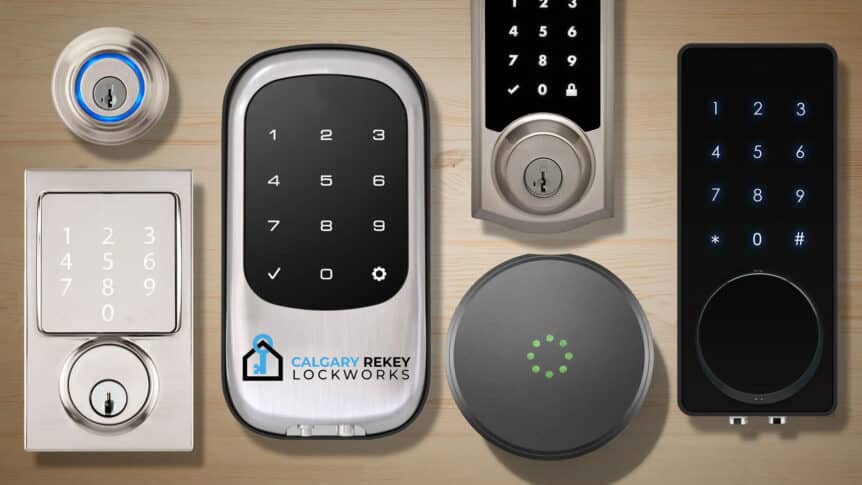Smart home devices allow you to unlock doors from anywhere through an app on your phone, or they can open when you’re near your front door. While smart locks won’t necessarily make your home any safer, they do allow for more control and efficiency. Not only will they make sure you never again have to drop everything in your hands to look for keys, but smart locks can lock and unlock your door from anywhere and extend digital “keys” to friends, family, caregivers, or anyone else who regularly visits your home.
Sure, you can still use a regular old key to open a smart-lock-equipped door (or most of them, anyhow), but don’t be too quick to discount the convenience of connectivity — especially when your hands are full of grocery bags, squirming tiny humans or anything else that makes it tough to rummage around for your keys. And when you crawl into bed, only to second guess whether you locked the door or not, you won’t need to throw on a bathrobe and stumble to the front door. You can simply pick up your phone and check the lock status.
That said, not all smart locks are the same. There are keyless options, Bluetooth options, locks that use your fingerprint, locks that fit on your existing deadbolt, and complete deadbolt replacement locks. It can be tricky to navigate if you’re new to smart home tech. Here’s a look at today’s smart lock options, what you need to know before buying one, and how to choose the right lock for your needs.
Should you keep or replace your existing deadbolt?
With some smart locks, you can hang on to the deadbolt that you already have. They’re typically described as “retrofit” options, and they can be great for renters or anyone not wanting to change keys.
Picking a protocol: Bluetooth, Z-Wave or Wi-Fi
- Bluetooth is a common smart-lock protocol because it doesn’t burn through battery life as quickly as Wi-Fi does. After all, it’s not like you can plug your deadbolt in, and who will remember to change the batteries on a door lock? With Bluetooth, your lock’s batteries should last a year or longer.
- Z-Wave smart locks are available from brands like Schlage, Poly-Control, and others. Unlike Bluetooth locks, Z-Wave locks don’t connect directly with your phone. Instead, they’ll need to connect to a Z-Wave-compatible hub. That hub will translate the lock’s Z-Wave signal into something your router can understand — once it does, you’ll be able to connect with your lock from anywhere.
- With Wi-Fi enabled, you can lock and unlock your door remotely, create new users or access codes from anywhere, and view your lock’s status and activity log. Connecting your smart lock to the internet with Wi-Fi is going to give you the most options for features, including integration with Google Assistant or Amazon Alexa.
In addition, products like the Schlage Sense Bluetooth Deadbolt , the Kwikset Premis, and the second-gen August Smart Lock and newer models work with Apple’s HomeKit, Apple’s own network of smart home devices that harnesses the voice-control powers of Siri to control your lock. The Schlage model works with Siri today, and August allows you to use voice control to lock and unlock your door with a PIN code.
Then there’s Amazon’s Alexa. After first rolling out support for the August Smart Lock, Amazon’s virtual voice assistant now has an entire set of software development tools for smart lock integrations, along with a whole host of partners, including Yale, Kwikset, Schlage and the Z-Wave Alliance. As a result, it’s easier than ever to find a smart lock that you can control with Alexa voice commands for locking, unlocking or checking the lock status.
Google is also in the mix with Google Assistant. August smart locks work with Google and Nest, owned by Google, has partnered with Yale on a smart lock designed to work with the Nest Secure system that includes Nest’s Weave technology for wireless smart home communication.
There are clear variations among smart locks in terms of installation, wireless technology and integration with third-party products, but they all do roughly the same thing — give you advanced, remote control access to a space. But there are still nuances in terms of how that advanced smart control happens.
Most Schlage, Kwikset and Yale locks, including the Schlage Sense Bluetooth Deadbolt, the Schlage Camelot Touchscreen Deadbolt, the Yale Real Living Touchscreen Z-Wave Deadbolt and the Nest x Yale lock all have touchpads. Don’t have your lock’s app pulled up? Just enter your secret code and voila! Your door will open without a key.
That said, installing a smart lock doesn’t necessarily mean giving up your key. You might not need to use one if you choose to rely on coded or app-enabled entry, but most smart locks still let you use your key, too.
If it detects your phone, the Kwikset Kevo will let you in with a single tap on the lock. Others, like the Yale Assure SL Touchscreen Deadbolt and the Kwikset Obsidian, ditch the keyway altogether. With smart locks like those, you can lose your keys for good — and there’s zero risk of someone breaking in by picking your lock.
Locks like August don’t come with touchpads as a standard option, but they do offer plenty of useful automatic functions — use the auto-unlock feature and you shouldn’t have to do anything — no app, no secret pin, no effort at all. August’s Smart Lock Pro and Wi-Fi Smart Locks also come with DoorSense, a small sensor that can tell you if your door is open, closed, locked, or unlocked.
Some locks offer scheduled key codes, allowing certain access codes to work only during specific days and times. Some locks also include activity history, letting you know when doors are locked and unlocked and by which access codes. The Kwikset Premis allows you to limit access to specific days and times or create codes that expire after a set amount of time.
Another general concern is battery life, but this will vary significantly (for all smart locks) based on how much you lock or unlock your door, the quality of the batteries you’re using, if your deadbolt occasionally sticks and requires extra effort from the built-in motor, and even the weather — colder temperatures can hurt battery life. Battery power shouldn’t deter you from buying a smart lock you love, though. In fact, almost all keyless smart locks now include a pair of jumpstart nodes on the bottom of the lock. Grab a 9V battery and connect it to the nodes for just enough power to enter your keypad code and unlock the lock.

In-home delivery is happening
Smart locks can grant convenient access to more than just your friends, family and neighbors. An Amazon Key kit includes the Amazon Cloud Cam and compatible smart lock for in-home delivery of all your Prime packages. Current smart lock choices include models from Kwikset, Yale and Schlage. You can check out the options on Amazon’s Key site. Amazon Key aims to eliminate the porch problem by letting delivery people put packages inside your front door.
In the end, there’s no right answer in terms of the model you should buy, but considering what connection method lines up with your smart home, and what, if any, third-party devices you’d like your lock to work with — will help you narrow down your options so you can quickly find the right smart lock for you.
Remember to research thoroughly, read reviews, and ask pertinent questions and feel comfortable in deciding on selecting Calgary Rekey Lockworks to trust with your locksmithing needs. Check out our A+ rating on the Better Business Bureau.

